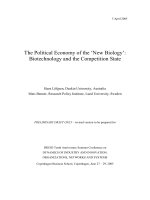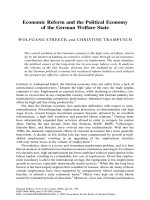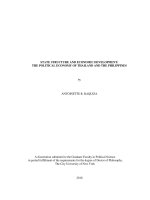- Trang chủ >>
- Khoa Học Tự Nhiên >>
- Vật lý
the samaritans dilemma the political economy of development aid nov 2005
Bạn đang xem bản rút gọn của tài liệu. Xem và tải ngay bản đầy đủ của tài liệu tại đây (1.67 MB, 287 trang )
THE SAMARITAN’S DILEMMA
This page intentionally left blank
The Samaritan’s Dilemma:
The Political Economy of
Development Aid
CLARK C. GIBSON, KRISTER ANDERSSON,
ELINOR OSTROM, AND SUJAI SHIVAKUMAR
1
3
Great Clarendon Street, Oxford OX2 6DP
Oxford University Press is a department of the University of Oxford.
It furthers the University’s objective of excellence in research, scholarship,
and education by publishing worldwide in
Oxford New York
Auckland Cape Town Dar es Salaam Hong Kong Karachi
Kuala Lumpur Madrid Melbourne Mexico City Nairobi
New Delhi Shanghai Taipei Toronto
With offices in
Argentina Austria Brazil Chile Czech Republic France Greece
Guatemala Hungary Italy Japan Poland Portugal Singapore
South Korea Switzerland Thailand Turkey Ukraine Vietnam
Oxford is a registered trade mark of Oxford University Press
in the UK and in certain other countries
Published in the United States
by Oxford University Press Inc., New York
© C. Gibson, K. Andersson, E. Ostrom, and S. Shivakumar, 2005
The moral rights of the authors have been asserted
Database right Oxford University Press (maker)
First published 2005
All rights reserved. No part of this publication may be reproduced,
stored in a retrieval system, or transmitted, in any form or by any means,
without the prior permission in writing of Oxford University Press,
or as expressly permitted by law, or under terms agreed with the appropriate
reprographics rights organization. Enquiries concerning reproduction
outside the scope of the above should be sent to the Rights Department,
Oxford University Press, at the address above
You must not circulate this book in any other binding or cover
and you must impose the same condition on any acquirer
British Library Cataloguing in Publication Data
Data available
Library of Congress Cataloging in Publication Data
Data available
Typeset by Newgen Imaging Systems (P) Ltd., Chennai, India
Printed in Great Britain
on acid-free paper by
Biddles Ltd., King’s Lynn, Norfolk
ISBN 0–19–927884–9 978–0–19–927884–8
ISBN 0–19–927885–7 (Pbk.) 978–0–19–927885–5 (Pbk.)
13579108642
Acknowledgments
This book is the product of more than four years of work by a team of researchers
who were, until June of 2001, all members of the Workshop in Political Theory and
Policy Analysis at Indiana University. The initial stimulus for doing this study was a
Request for Proposal sent out in November of 1999 by the Department for Evaluation
and Internal Audit of the Swedish International Development Cooperation Agency
(Sida). In this request, Sida sought an analysis of incentives in the delivery of devel-
opment aid. We thought the subject matter so intriguing and potentially important
that we threw our hats into the ring, and were delighted to have been chosen by Sida
for this project in February of 2000.
Our final report—Aid, Incentives, and Sustainability: An Institutional Analysis of
Development Cooperation, Sida Studies in Evaluation 02/01 (E. Ostrom et al. 2002)—
was widely distributed to aid agencies and scholars in many countries of the world.
We were gratified to see it generate such interest that we received multiple requests
to broaden our initial study and rewrite the report as a book. You now hold the fruits
of this effort. We have spent the last 18 months broadening the theoretical scope
of the report while drawing on our empirical studies of Sida and Sida projects to
illustrate our general theoretical orientation.
The overall objective of this book is to introduce a new approach to the study of
development aid, an approach that puts the institutional incentives at the center of
the development process. We have written this book with the hope that students,
researchers, and other individuals who are interested or even directly involved with
development aid activities, will learn to apply this approach, and through it gain new
insights about the relationships between aid, incentives, and sustainability.
We develop our approach in three stages. First, we review and discuss the state-
of-the-art regarding the existing knowledge about incentives and aid. Second, we
develop a series of theoretical propositions about the origins of institutional incent-
ives among the different actors who operate within the development aid process.
Throughout the book, we draw on these ideas to identify multiple relationships
between aid, incentives, and sustainability that are relevant to all aid actors. Finally,
we apply and illustrate the theoretical propositions in concrete field settings in
Sweden, India, and Zambia.
During multiple visits to Sida headquarters, the Workshop team reviewed more
than 100 documents to assess the degree to which the role of incentives is discussed.
In Stockholm, we conducted 111 interviews including Sida staff members at all
levels, public officials at two Ministries, and consultants familiar with Sida projects.
In India and Zambia, we conducted an additional 66 interviews with Sida staff
members, recipient government officials, and project organizations associated with
the five projects chosen in India and Zambia. The methods used in that initial study
are described in E. Ostrom et al. (2002, appendix C). There we also reproduced the
interview forms that we used for structured interviews and the lists of persons
interviewed in Stockholm and related to the projects selected in India and Zambia.
We do not make specific references to particular individuals interviewed since we
assured each of them of the anonymity of their interviews with us. From these
interviews, we gained information on the perceptions of Sida staff and others working
closely with Sida regarding incentives and their concerns and consciousness of how
incentives are related to sustainability.
Why did We do This Study?
Our main motivation for doing this study, and for allocating some of our own research
funds to it, is our deep concern with the long history of frustrated efforts to enhance
political and economic development of many of the poorest countries in the world.
In our prior “ground-up studies,” we had observed a number of instances in which
local efforts to create not-for-profit or for-profit organizations providing needed
goods and services had been stymied by donor-funded projects of their own national
government (E. Ostrom et al. 1994; Shivakoti et al. 1997; Sowerwine et al. 1994).
Further, we were already engaged in a number of studies of national-level policy mak-
ing and its impacts on development processes (Andersson 2003, 2004; Gibson 1999;
Gibson and Lehoucq 2000; Shivakumar 2005), and were beginning work on the
impact of international assistance in the area of humanitarian aid (McGinnis 1999c).
The opportunity to work with one of the world’s leading development assistance
agencies—Sida—to examine how incentives could lead well-intentioned individuals
to produce results that at times were unintended and counterproductive, also appealed
to us. Sida, by simply commissioning this study, signaled that it was willing to consider
some of the most perplexing problems facing international development assistance
today. Further, Sida and other closely related agencies and researchers in Sweden had
already undertaken some path-breaking studies of how institutional structures lead
to the potential for perverse incentives (Bräutigam 2000; Catterson and Lindahl 1999;
Eriksson Skoog 2000; Sida 1999b). Indeed, it was important to us that our work on
this difficult topic—concerning theoretical developments, empirical findings, and
policy recommendations—would be taken seriously by the agency requesting the
original study. Indeed, in the meetings we have had with Sida after the delivery of
our original report, we were very impressed with the depth of their interest in our
approach and conclusions.
We hope that other international donors and the scholars who study development
will also find the expanded study of value to them. When individuals trying to do
good find themselves hampered in these efforts by the incentives they face, it is quite
important that one steps back to examine what these incentives are and how they can
induce behavior that slows down development rather than enhancing it.
We are deeply indebted to all of the individuals who gave us substantial time when
we talked with them or helped to dig out documents, data, and archival materials. At
the Workshop, we have benefited greatly by interactions with our larger team including
Acknowledgments
vi
Professors Matthew Auer, Roy Gardner, Michael McGinnis, and Christopher
Waller (now at Notre Dame). We are glad that Matthew Auer could join Krister
Andersson in co-authoring Chapter 8 in light of his own extensive prior experience
and the large number of interviews he conducted in Stockholm for the original
study. We are also glad that Roy Gardner and Christopher Waller were able to revise
an excellent technical appendix from the original study for the broadened Chapter 5
of the current book. We thank Eduardo Araral, Sarah Kantner, Shaun McMahon,
Esther Mwangi, Amy Poteete, and Enrico Schaar for their useful input. Frank Van
Laerhoven drew on his own long experience in development assistance to provide
us with effective critiques of all of the chapters in the current book. And, without
Patty Lezotte, we could never have survived the fact that we are now separated
and located on the opposite coasts of the United States. She interpreted our confused
emails and made sense of our contorted files. Her editorial skills are famous, as is
her patience.
We are also appreciative of the welcomes we earlier received in Stockholm on
multiple occasions from Sida staff—Anders Berlin, Gun Eriksson Skoog, and
Ann-Marie Fallenius of UTV—and of the extensive help offered to us by Malin
Karlsson, Stefan Engström, and Wendy Fryer. We deeply appreciate the funding
provided to us by Sida at the time of our initial study as well as by Indiana University,
the Ford Foundation, and the MacArthur Foundation for our broader research mis-
sion. We thank the many individuals throughout Sida who took the time to talk to us
and who have given us extensive comments on our report. We also received excellent
comments on the initial report from Bertin Martens, Mary Shirley, and Ingemar
Gustafsson.
For the India case studies, we appreciate the help of Anita Ingevall and Farhad
Irani, Lars Lagging, and Elisabeth Ekelund at Sida in Stockholm. We are indebted
to Sida’s office at the Embassy of Sweden in New Delhi for many kind courtesies
extended. Owe Andersson, Jonas Lövkrona, and Ramesh Mukalla were generous with
their time and their wisdom in discussing a range of issues relating to incentives and
ownership. Also, in New Delhi, Rita Acharya, at the Indian Ministry of Finance and
Jagmohan Bajaj, formerly Finance Secretary to the Government of India, took time
to inform us on the conduct of bilateral aid.
For the Orissa project, we thank the Orissa Forest Department, in particular
P. R. Mohanty and S. C. Mohanty. Neera Singh of Vasundara helped us to under-
stand many of the complex issues involved in Orissa forestry. N. C. Saxena was, as
always, courteous and knowledgeable. For the Maharashtra project, we appreciate the
kind help of Carl-Göte Carlsson of ABB-India, Pramod Deo of the Maharashtra
Secretariat, and V. S. Patnai of the Maharashtra State Electricity Board.
The Workshop team that traveled to Zambia received crucial help from both Sida
staff and Zambian officials. Ambassador Kristina Svensson allowed her embassy
staff the time to help us with both the logistics of this study and to lend their
considerable expertise to our work; we would like to especially thank embassy staffers
Göran Hedebro, Marie Holmlund, Mulenga Muleba, and Torsten Andersson. In
addition to Sida staff, the number of individuals who gave us some of their valuable
Acknowledgments
vii
time and insights include: Peter Aamodt (Zambia Chamber of Commerce and
Industry), Peter Agaard (CFU), Kuwana Akapelwa (ZESCO), Cyprian Chitundu
(ZESCO), Ian Fraser (Zambian Privatization Agency), Dutch Gibson (CFU), Andrew
Kamanga (ERB), Namukolo Mukutu (GART), Teddy Mwale (ZESCO), Jacob
Mwanza (Bank of Zambia), J. Mwenechanya, Olle Otteby (Sida consultant), Matthew
Phiri (ZESCO), Raphael Salasini (formerly of ERB), Chatis Vlahakis and team (CFU),
J. Zyambo (ZNFU), and Moses Zama (ERB). To these individuals, as well as the
other 40 people we interviewed in Zambia, we extend our deep thanks.
Even after such extensive help, we are sure that this book still contains errors. To
these, we claim complete ownership.
Acknowledgments
viii
Contents
List of Boxes xvi
List of Figures xvii
List of Tables xviii
List of Acronyms and Abbreviations xix
List of Contributors xxi
Part I. Introduction
1. What’s Wrong with Development Aid? 3
1.1. Rethinking development aid 3
1.2. Incentives, development aid, and the plan of this book 5
1.2.1. Perverse incentives in day-to-day interactions
1.2.2. Perverse incentives in the policy process
1.2.3. Perverse incentives in the development aid system
1.2.4. Perverse incentives in donor agencies
1.2.5. Cases in recipient countries
1.3. Five key concepts for the institutional analysis of development aid 7
1.3.1. Institutions (and their close cousins)
1.3.2. Incentives
1.3.3. Development, development aid, and development cooperation
1.3.4. Sustainability
1.3.5. Ownership
1.4. Promoting development 13
1.4.1. Missing money?
1.4.2. Missing institutions?
1.4.3. Collective-action situations and development
1.4.4. Ownership and collective action
1.5. Conclusion 18
Part II. Theoretical Foundations
2. Laying the Theoretical Foundations for the Study
of Development Aid 23
2.1. Introduction 23
2.2. An overview of the institutional analysis and
development framework 24
2.3. Doing institutional analysis 25
2.3.1. Actors and action situations
2.3.2. Explaining outcomes within an action arena
2.3.3. The concept of rules
2.3.4. Biophysical/material conditions
2.3.5. Attributes of a community
2.4. Motivational problems at the operational level 35
2.4.1. Public goods and free-riding
2.4.2. Common-pool resource problems
2.4.3. The Samaritan’s Dilemma
2.4.4. Asymmetric power relationships
2.5. Information problems at an operational level 41
2.5.1. Missing information and local knowledge
Moral hazard
Principal–agent situations
2.5.2. Asymmetric information about characteristics
Adverse selection
Signaling problems
2.6. Solving operational-level problems 46
3. Better Development Through Better Policy? Development Aid’s
Challenges at the Collective-Choice Level 49
3.1. Introduction 49
3.2. Changing unproductive situations at the collective-choice level 50
3.3. Missing, weak, or bad institutions 53
3.4. Motivational problems at the collective-choice level 54
3.4.1. Rules as public goods
3.4.2. Rent seeking
3.4.3. Corruption
3.5. Informational problems at the collective-choice level 56
3.5.1. Missing and asymmetric information
Fiscal illusion
3.5.2. Translating preferences into outcomes—the
impossibility theorem
3.6. Enter the donor 57
4. Sorting Out the Tangle: Incentives Across Action Situations in
Development Aid 61
4.1. Introduction 61
4.2. The chain of aid delivery 62
4.3. The international development cooperation octangle 63
4.3.1. The full octangle
4.3.2. The donor–recipient negotiation arena
Strong donor—strong recipient
Contents
x
Strong donor—weak recipient
Enlightened donor—weak recipient
4.3.3. Principal–agent arenas within donor and recipient countries
Principal–agent relations—politicians and bureaucrats
Principal–agent relations—owners, donor agencies,
and contractors
4.3.4. Beneficiaries
Links between beneficiaries and government
Linking governments to citizens and interest groups
4.3.5. Competition among donors
4.4. Applying the IAD framework to analyze the donor–recipient dyad 75
4.5. Conclusion 84
5. A Formal Analysis of Incentives in Strategic Interactions
Involving an International Development Cooperation Agency,
Roy Gardner and Christopher J. Waller 87
5.1. Introduction 87
5.2. Strategic implication of altruism for results 88
5.2.1. Aid in a one-shot game: The Samaritan
5.2.2. Aid in a repeated game: The Samaritan’s Dilemma
5.2.3. Principal–agent problems in one-shot games
5.2.4. Principal–agent problems in repeated games
5.3. Foreign aid as a substitute for borrowing in capital markets 95
5.3.1. Aid conditionality
5.3.2. Aid tournaments
5.4. Externalities and market failures 99
5.4.1. Public good problems
5.4.2. Common-pool resource (CPR) problems
5.4.3. Corruption
5.5. Coordinated aid 108
5.6. Equity considerations 109
5.7. Warm-glow effects 110
5.8. Conclusion 111
6. All Aid is Not the Same: The Incentives of Different Types of Aid 112
6.1. Introduction 112
6.2. Aid as “carrots and sticks” 112
6.3. The configuration of aid capital 114
6.4. The characteristics of aid 115
6.4.1. Grants, credits, and guarantees
Grants
Credits
Guarantees
6.4.2. Tied-aid—Issues and incentives
6.4.3. Aid conditionality—Ex ante versus ex post
Contents
xi
6.5. The modalities of aid 120
6.5.1. Project aid
6.5.2. Program aid
6.5.3. Sector-wide approaches
6.5.4. Humanitarian assistance
6.5.5. Technical cooperation
6.6. Conclusion 127
Part III. Case Studies
7. Applying the IAD Framework: The Incentives Inside a
Development Agency 131
7.1. Introduction 131
7.2. Methods 132
7.3. Using the IAD framework to study the organization
of a development agency: Sida 133
7.3.1. Sida as an agent of the Swedish government and its people
7.3.2. Looking inside Sida
7.4. Contextual variables and their influences on action arenas 137
7.4.1. Institutional factors influencing action arenas
7.4.2. Cultural factors influencing the action arenas
7.4.3. Biophysical characteristics influencing the action arenas
7.5. Patterns of interactions: Incentives for learning
about sustainable outcomes 141
7.5.1. A highly motivated staff
Individual learning about sustainability
Empirical evidence on the conditions for individual
learning about sustainability
Short-term assignments
Communication after an assignment
Temporary contracts
Retention and recruitment of younger staff
Career advancement criteria related to
performance of past projects
7.6. Organizational learning through formal evaluations 150
7.7. Empirical evidence on organizational learning through evaluations 151
7.8. A formal evaluation process without much learning 153
7.9. Budgetary processes oriented toward sustainability 154
7.10. Conclusions 156
8. Incentives for Contractors in Aid-Supported Activities,
Krister Andersson and Matthew R. Auer 160
8.1. Introduction 160
8.2. The place of contractors in aid programs 161
Contents
xii
8.3. Incentives for contractor performance 162
8.3.1. Pre-design phase
8.3.2. Design phase
8.3.3. Implementation phase
8.4. Incentive incompatibilities: Control versus ownership 165
8.5. Contractors’ incentives and the prospects for sustainability 166
8.5.1. Is a consultant-directed project likely to be sustainable?
8.5.2. What is the role of the consultant in ownership?
8.6. The Sida contractors’ perceptions 167
8.6.1. “For whom do we work?”
8.6.2. Contractors’ perceptions of relationship to Sida
8.6.3. What makes a consultant tick?
9. Sida Aid in Electricity and Natural Resource Projects in India 171
9.1. Using institutional analysis 171
9.2. Sweden’s development cooperation with India 172
9.2.1. Changing strategic interests in bilateral
development assistance
9.2.2. Aid and institutional reform in the states
9.3. Capacity building for participatory management of
degraded forests in Orissa 174
9.3.1. History of the project
9.3.2. An institutional analysis of the Orissa Capacity
Building Project
The action arena
Rules-in-use—A return to community-based forest management
9.3.3. The role of key actors
The Orissa Forest Department
The government of Orissa
Sida
Scandiaconsult Natura
NGOs
9.3.4. Interactions within the octangle
The Sida—Orissa Forest Department—forest
communities triad
The Sida—Scandiaconsult Natura—Orissa Forest Department triad
9.3.5. Implications for ownership and sustainability
9.4. The Chandrapur–Padghe HVDC Converter Terminal Project 184
9.4.1. History of the project
9.4.2. An institutional analysis of the Chandrapur–Padghe Project
The action arena
Rules-in-use: Governance in the power sector
A free-rider problem
Contents
xiii
9.4.3. Interactions within the octangle
The recipient government—MSEB—interest group triad
The donor government—Sida—special interests triad
The donor—other donors—recipient triad
The contractor at the center
Recipient beneficiaries
9.4.4. Implications for ownership and sustainability
9.5. Conclusions 194
10. Sida Aid in Electricity and Natural Resource Projects in Zambia 198
10.1. Introduction 198
10.2. Zambia’s experience with development cooperation 198
10.2.1. Sweden’s role in Zambia’s development
10.3. The Zambian ERB 200
10.3.1. History of the ERB project
10.3.2. An institutional analysis of the ERB
Actors and the action situation
Influences on the action arena
10.3.3. Patterns of interaction: Incentives and the ERB
Incentives of government
Incentives of ZESCO
Incentives of the ERB
Incentives for the public and interest groups
Incentives for Sida
10.3.4. Outcomes: Implications for ownership and sustainability
10.4. The Kafue Gorge Hydropower Station Rehabilitation Project 207
10.4.1. Project history
10.4.2. An institutional analysis of the KGRP
The action arena
Influences on the action arena
10.4.3. Patterns of interaction
Incentives of government
Incentives of ZESCO
Incentives for Sida
Incentives for Swedpower
10.4.4. Outcomes: Implications for ownership and sustainability
10.5. The CFU 211
10.5.1. History of the project
10.5.2. An institutional analysis of the CFU
Action arena
Influences on the action arena
Community attributes
Institutional context and rules-in-use
10.5.3. Patterns of interaction: Incentives and the CFU project
Contents
xiv
Incentives of CFU project managers
Incentives for MAFF
Incentives for Sida
Incentives for conservation farming promoters
10.5.4. Implications for ownership and sustainability
10.6. Conclusions 219
Part IV. Conclusion
11. What Have We Learnt About Aid? 223
11.1. Awareness of the role of incentives 224
11.2. The nature of the good 225
11.3. Ownership and sustainability 226
11.4. Encouraging learning at the individual and organizational levels 229
11.5. The role of consultants 231
11.6. Putting beneficiaries first 232
Bibliography 235
Index 253
Contents
xv
List of Boxes
Box 2.1. General questions all development projects should ask 46
Box 3.1. Specific questions all development projects should ask regarding
the collective-choice level 60
List of Figures
1.1. Design matrix for case studies 7
2.1. The most general elements of institutional analysis 26
2.2. A framework for institutional analysis 26
2.3. The Samaritan’s Dilemma 38
4.1. The chain of aid delivery 62
4.2. The international development cooperation octangle 64
4.3. The donor–recipient bargaining arena 65
4.4. Principal–agent relationships within donor and recipient governments 69
4.5. Beneficiaries in development cooperation 73
4.6. Action–outcome linkages for simplified donor–recipient
negotiation situations 79
5.1. Principal–agent problem, extensive form game 90
5.2. Game G: Principal–agent problem, normal form game 93
5.3. Game Gϩ: Normal form game with a passive player 94
5.4. Game Gϩϩ: Normal form game, player 3 is active 96
5.5. Public goods game in normal form 100
5.6. Tragedy of the commons 102
5.7. Equilibrium in corruption regimes 106
7.1. Sida top-level organizational chart 135
7.2. Multiple action situations of development cooperation from
the perspective of a Sida staff member 137
7.3. Type of rules affecting Swedish aid 138
7.4. Distribution of permanent and temporary staff at Sida
from 1995–1999 146
8.1. The place of contractors in the development octangle 162
8.2. (a) The de jure principal–agent relationship of implementation 164
(b) The de facto principal–agent relationship of implementation 164
9.1. Octangle diagram of the Capacity Building Project 176
9.2. Octangle diagram of the Chandrapur–Padghe Project 189
10.1. The octangle of actors for the case of the Zambian Energy
Regulation Board 202
10.2. The actors of the octangle for the Kafue Gorge Power Station
Rehabilitation Project 208
10.3. The international development cooperation octangle for the case
of the Conservation Farming Unit 213
List of Tables
7.1. Total disbursements of Sida budgets for 1997–2000 by quarter 139
List of Acronyms and Abbreviations
ABB Asea Brown Boveri
AC Alternating Current
ACF Agricultural Consultative Forum
Asien Asia Department (Sida)
BHEL Bharat Heavy Electrical Limited
BITS Swedish Agency for International Technical and Economic
Cooperation
CFLC Conservation Farming Liaison Committee
CFM Community Forest Management
CFU Conservation Farming Unit
CPR Common-Pool Resource
DC Direct Current
DEA Department of Economic Affairs
ERB Energy Regulation Board
ESW Economic and Sector Work
EU European Union
FDCs Folk Development Colleges
FDI Foreign Direct Investment
GoI Government of India
GoM Government of Maharashtra
GRZ Government of Zambia
HADO Hifadhi Ardhi Dodoma
HVDC High Voltage Direct Current
IAD Institutional Analysis and Development
IMF International Monetary Fund
JFM Joint Forest Management
KGRP Kafue Gorge Hydropower Station Rehabilitation Project
KGS Kafue Gorge Hydropower Station
KTS Contract Financed Technical Cooperation (Sida)
LDCs Less-developed countries
MAFF Ministry of Agriculture, Food, and Fisheries
MARP Millennium African Renewal Programme
MERC Maharashtra Electricity Regulation Commission
MFA Ministry of Foreign Affairs
MFi Ministry of Finance
MOU Memorandum of Understanding
MSEB Maharashtra State Electricity Board
Natur Department for Natural Resources and the Environment (Sida)
NGOs Nongovernmental organizations
List of Acronyms and Abbreviations
xx
NTFP Nontimber forest products
NTPC National Thermal Power Corporation
PFC Power Finance Corporation
PRP Power Rehabilitation Program
SEB State Electricity Board
SEK Swedish Kronor
Sida Swedish International Development Cooperation Agency
SIDA Swedish International Development Authority
SIs Sustainability Indicators
SMPP Second Maharashtra Power Project
SWAP Sector Wide Approach
USAID United States Agency for International Development
USGAO United States General Accounting Office
UTV Department for Evaluation and Internal Audit (Sida)
ZESCO Zambia Electricity Supply Corporation
ZNFU Zambia National Farmers Union
List of Contributors
Krister Andersson is assistant professor of political science and environmental
studies at the University of Colorado, Boulder, and an affiliated faculty member of
the Workshop in Political Theory and Policy Analysis at Indiana University. He
studies the politics of international development and environmental governance in
nonindustrial societies. His work has appeared in Public Administration and
Development, World Development, and the Journal of Environment and Development.
Matthew R. Auer is associate professor of public and environmental affairs at the
School of Public and Environmental Affairs, Indiana University. His research
focuses on the politics of foreign aid, international forest policy, and comparative
industrial environmental politics. He is editor-in-chief of the journal Policy Sciences.
Roy Gardner is Chancellor’s Professor of Economics and Remak Professor of West
European Studies at Indiana University. He is the author of Games for Business and
Economics (2004) and co-author of Rules, Games, and Common-Pool Resources (1994).
Clark C. Gibson is professor of political science at the University of California and
Director of the Program in International Studies. He studies the politics of
development, democracy, and the environment. In addition to dozens of articles,
he has written Politicians and Poachers (1999), and coedited the volumes
Communities and the Environment (2001) and People and Forests (2000).
Elinor Ostrom is the Arthur F. Bentley Professor of Government at Indiana
University and Co-director of the Workshop in Political Theory and Policy Analysis
and the Center for the Study of Institutions, Population, and Environmental
Change (CIPEC). She is the author of Understanding Institutional Diversity (2005)
and Governing the Commons (1990), as well as the editor of several other books on
institutional analysis, development, and resource policy.
Sujai Shivakumar is a policy advisor with the Board on Science, Technology, and
Economic Policy of the National Research Council, Washington, DC. He is the author
of The Constitution of Development: Crafting Capabilities for Self-Governance (2005).
Christopher J. Waller is the G. Schaefer Chair of Economics in the Department
of Economics and Econometrics at the University of Notre Dame. He specializes
in political economy of central banking and his work has appeared in American
Economic Review and Quarterly Journal of Economics.
This page intentionally left blank
PART I
INTRODUCTION
This page intentionally left blank









